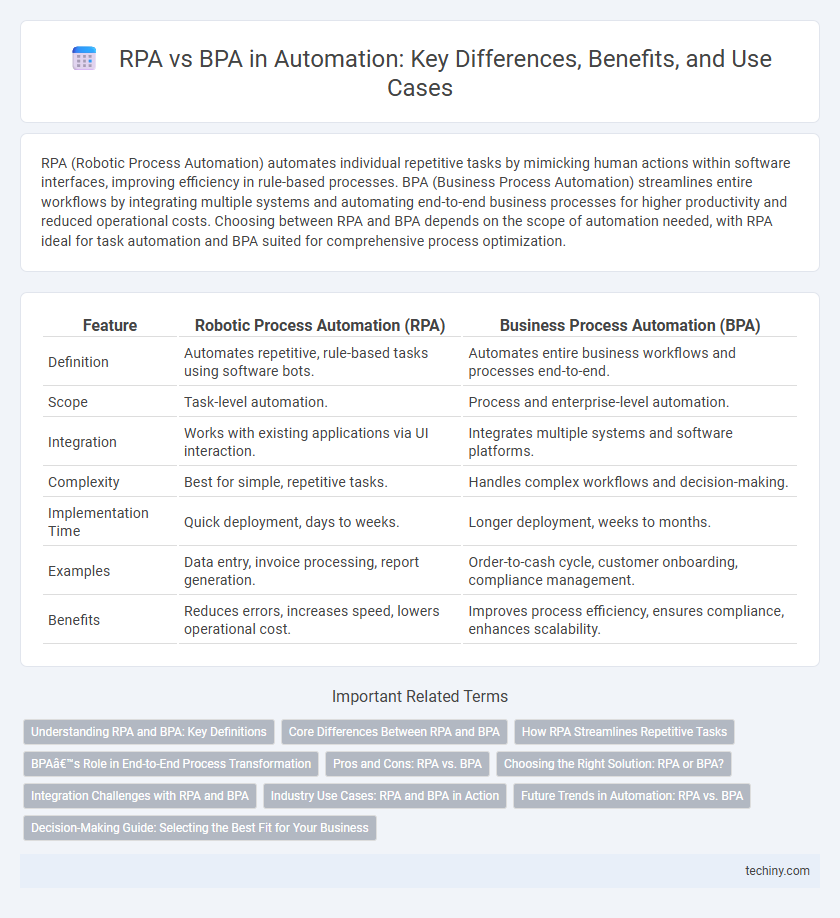RPA (Robotic Process Automation) automates individual repetitive tasks by mimicking human actions within software interfaces, improving efficiency in rule-based processes. BPA (Business Process Automation) streamlines entire workflows by integrating multiple systems and automating end-to-end business processes for higher productivity and reduced operational costs. Choosing between RPA and BPA depends on the scope of automation needed, with RPA ideal for task automation and BPA suited for comprehensive process optimization.
Table of Comparison
| Feature | Robotic Process Automation (RPA) | Business Process Automation (BPA) |
|---|---|---|
| Definition | Automates repetitive, rule-based tasks using software bots. | Automates entire business workflows and processes end-to-end. |
| Scope | Task-level automation. | Process and enterprise-level automation. |
| Integration | Works with existing applications via UI interaction. | Integrates multiple systems and software platforms. |
| Complexity | Best for simple, repetitive tasks. | Handles complex workflows and decision-making. |
| Implementation Time | Quick deployment, days to weeks. | Longer deployment, weeks to months. |
| Examples | Data entry, invoice processing, report generation. | Order-to-cash cycle, customer onboarding, compliance management. |
| Benefits | Reduces errors, increases speed, lowers operational cost. | Improves process efficiency, ensures compliance, enhances scalability. |
Understanding RPA and BPA: Key Definitions
Robotic Process Automation (RPA) utilizes software robots to mimic repetitive human tasks, enhancing operational efficiency without altering existing systems. Business Process Automation (BPA) encompasses a broader range of automation techniques aimed at streamlining complex business workflows and improving end-to-end process performance. Understanding RPA as task-centric automation and BPA as process-centric automation is crucial for selecting the best automation strategy for organizational needs.
Core Differences Between RPA and BPA
Robotic Process Automation (RPA) specializes in automating repetitive, rule-based tasks by mimicking human actions on user interfaces, enhancing efficiency without altering underlying systems. Business Process Automation (BPA) encompasses a broader scope, integrating multiple processes and systems to optimize end-to-end workflows, often involving complex decision-making and data management. Key differences lie in RPA's task-level focus versus BPA's comprehensive process redesign and orchestration capabilities.
How RPA Streamlines Repetitive Tasks
Robotic Process Automation (RPA) streamlines repetitive tasks by automating rule-based, high-volume activities such as data entry, invoice processing, and customer service interactions, reducing human error and increasing operational efficiency. Unlike Business Process Automation (BPA), which focuses on end-to-end process optimization across multiple systems, RPA targets specific repetitive tasks within existing workflows without altering the underlying infrastructure. This task-specific automation accelerates processing times and frees employees to focus on strategic, higher-value work.
BPA’s Role in End-to-End Process Transformation
Business Process Automation (BPA) enables end-to-end process transformation by integrating multiple systems and workflows to streamline operations beyond task-level automation offered by Robotic Process Automation (RPA). BPA leverages advanced technologies such as workflow orchestration, analytics, and artificial intelligence to optimize entire business processes, improve decision-making, and enhance scalability. This holistic approach drives significant efficiency gains, reduces errors across interconnected tasks, and aligns with strategic organizational goals.
Pros and Cons: RPA vs. BPA
Robotic Process Automation (RPA) excels in automating repetitive, rule-based tasks, significantly reducing human error and operational costs while enabling quick deployment without major system overhaul. However, RPA struggles with complex processes requiring cognitive understanding and lacks scalability in dynamic environments. Business Process Automation (BPA) offers comprehensive workflow optimization, integrating diverse systems for end-to-end process management and enhancing efficiency across departments, but it demands higher initial investment and longer implementation times compared to RPA.
Choosing the Right Solution: RPA or BPA?
Selecting between Robotic Process Automation (RPA) and Business Process Automation (BPA) depends on the scope and complexity of tasks within an organization. RPA excels at automating repetitive, rule-based tasks by mimicking human interactions with software, ideal for high-volume, routine workflows. BPA offers comprehensive process optimization by integrating multiple systems and automating end-to-end business processes, making it suitable for strategic improvements and scalability.
Integration Challenges with RPA and BPA
Robotic Process Automation (RPA) and Business Process Automation (BPA) face distinct integration challenges due to their different scopes and technologies. RPA often struggles with integration because it relies on user interface interactions, making it fragile against software updates and incompatible with deeply embedded systems. BPA, designed for end-to-end process optimization, demands complex integration with existing IT infrastructures, requiring robust APIs and data synchronization frameworks to ensure seamless operations across multiple platforms.
Industry Use Cases: RPA and BPA in Action
Robotic Process Automation (RPA) excels in repetitive, rule-based tasks such as invoice processing and customer service automation across finance and retail sectors. Business Process Automation (BPA) drives end-to-end workflow optimization, integrating multiple systems for complex processes like supply chain management and HR onboarding in manufacturing and healthcare industries. Combining RPA with BPA enhances operational efficiency, reduces errors, and accelerates business transformation across diverse industry use cases.
Future Trends in Automation: RPA vs. BPA
Future trends in automation indicate a growing integration of Robotic Process Automation (RPA) and Business Process Automation (BPA) to enhance operational efficiency and scalability. Advanced AI-driven RPA tools are expected to evolve beyond routine task automation to include cognitive functions such as decision-making and natural language processing. BPA platforms will increasingly incorporate machine learning and analytics for end-to-end process optimization, enabling businesses to achieve real-time insights and agile workflow management.
Decision-Making Guide: Selecting the Best Fit for Your Business
Robotic Process Automation (RPA) excels in automating repetitive, rule-based tasks to increase efficiency and reduce errors, ideal for straightforward, high-volume workflows. Business Process Automation (BPA) offers a comprehensive approach, integrating multiple systems and workflows for end-to-end process optimization and improved decision-making. Selecting the best fit depends on the complexity of business processes, with RPA suited for task-level automation and BPA for strategic process transformation.
RPA vs BPA Infographic

 techiny.com
techiny.com